Combining an aquarium and a garden is actually possible. Growing dill with parsley on the windowsill and enjoying the flickering of colorful fish is not a fantasy. The modern direction in agriculture for the cultivation of fish and plants has long been working on this principle, for example, in Australia. Now at home you can place a miniature water farm. This is a small vessel with water, planted on top with pots of fresh herbs.

History of creation
Two Californians, graduates of a research university in Berkeley (California), came up with a small ecosystem - Nikil Arora and Alejandro Velez. They decided to create a mini-farm that is harmless to people and the environment. The inventors attracted a group of researchers to implement their idea: in hydroponics, aquaculture, biology, engineering and design. As a result, they received a design convenient for offices, kindergartens, schools and residential buildings. Such a mini-garden is indispensable in megacities, where wildlife is becoming less and less.
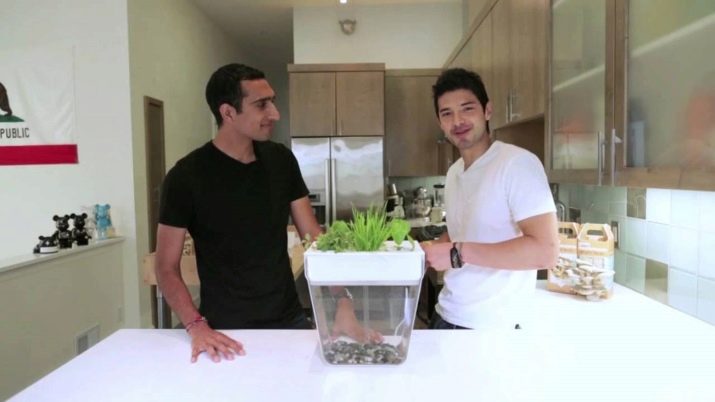
The aqua farm is a mini-aquarium that independently maintains the purity of water, and also grows environmentally friendly greens for the table. It works in hydroponics - plants grow without soil.
The Aztecs found the origins of such an agronomic system: islands (chinamps) were poured in shallow fresh lakes off the coast and fertilized with lake mud, even if there was no rain, water rose to the roots from the lake. In this way planted maize, beans, tomatoes, pumpkin, hot pepper. Up to 4 crops were sometimes harvested in one year.
In southeast Asia, rice is planted in floodplains and carps, eels, crucians and snails are hatched. Fish destroys pests, fertilizes the soil and is a source of nutrition for people. In the aqua farm, hydroponics is combined (plants are grown without soil) and aquaculture (keeping fish) - this is called aquaponics: fish waste is processed by special bacteria and then green shoots feed on them, and clean water is sent back to the aquarium. Aquaponics is a promising area of aquaculture. In this economical way useful plants are grown and water is purified from organic residues of cultivated fish.
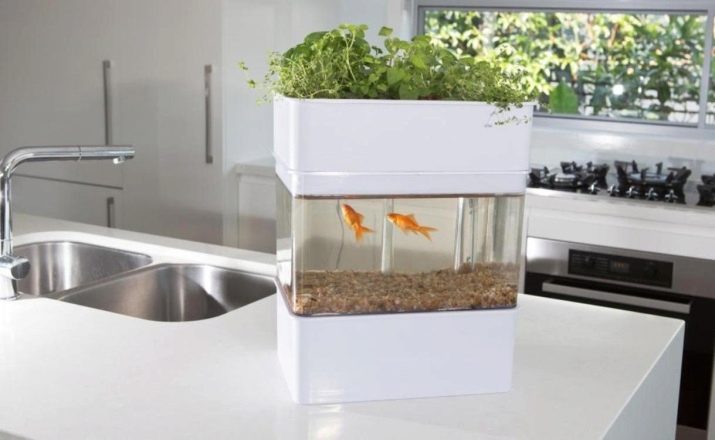
Features and purpose
At home, there are no restrictions on growing green crops in such an ecosystem. Moisture-loving species are best suited. They grow year round. A few days after planting the seeds will already appear sprouts.
Leafy greens, spicy herbs grow well in the water farm, and oats and wheat are well-suited.
Important! Some are interested, or you can plant flowers like that. Indoor flowers with this method of maintenance will lack nutrients, but why not try: there are species that feel good on hydroponics.
It is better to place the aquarium in a sunny place, for example, at the south window. Basil, lettuce love the abundance of sunlight, but you need to pay attention so that direct rays do not fall on the water, from which it can bloom. Wheat is less demanding on lighting; you can choose this crop if there is a little light in the room. A small lamp will help out on cloudy days or on long winter evenings. Wheat, basil, buckwheat, flax and lentils grow well in small pots. In addition to them, you can grow in a small garden: salad arugula, parsley, dill, mint, cilantro.
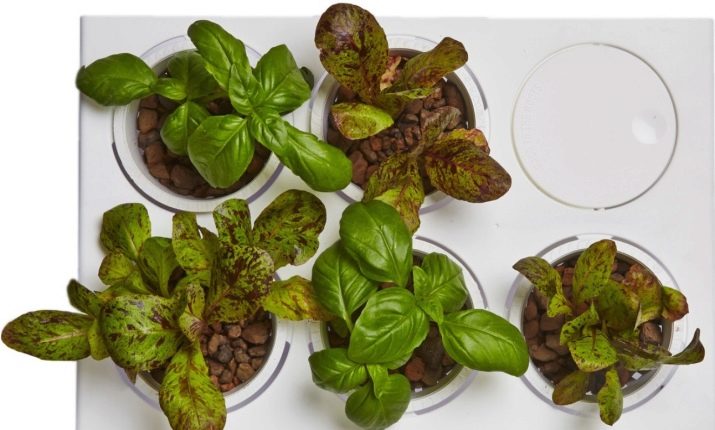
A farm is a miniature ecosystem enclosed in a circle as follows:
- food residues and fish waste are pumped into the pots with water, thereby providing nutrition to the greenery;
- plants purify water.
- water returns to the aquarium.
Fish feed green friends, and they, in gratitude, serve as filters for water - this is decorative mini aquaponics.
Water from the vessel gradually evaporates over time and must be added.
The tank can contain from 3 to 5 inhabitants. The main requirement is that the fish is insensitive to ammonia and nitrites dissolved in water.
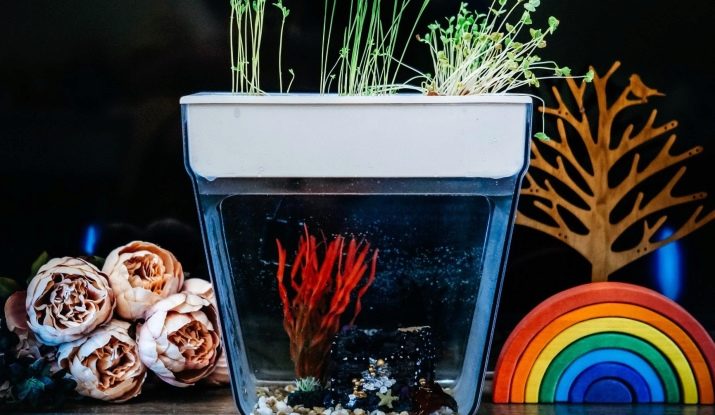
Several breeds of fish are suitable for growing.
- Guppy. These are unpretentious freshwater fish. They are considered the most suitable pets for beginner aquarists. They love fresh and clean water, so the first weeks of their stay on the farm, while the ecosystem process has not started, they must be watched.

- Danio rerio or zebra. These are mobile and striped fish with long fins, they are quite sensitive to changes in the composition of water, especially at a young age. They recommend placing 3 individuals in the aquarium, they are schooling fish, otherwise they will feel uncomfortable.

- Siamese cockerel. It is strongly advised to choose a cockerel. He proved himself very well in the aqua farm, but only alone - in company with others, he can behave belligerently.
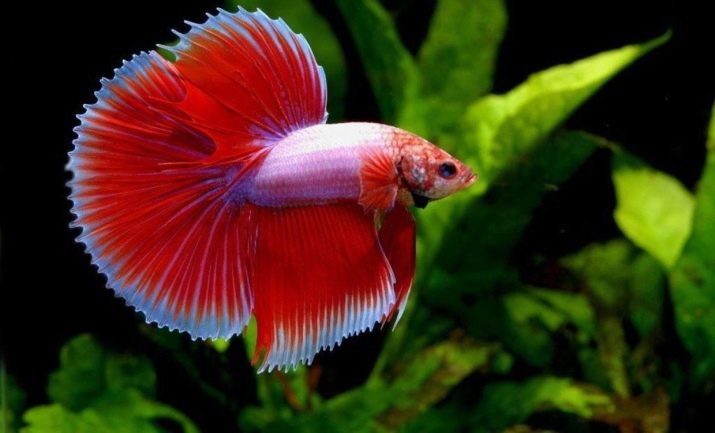
- Gold fish. For a goldfish, the size of the aquafarm is cramped. When she grows up, she will have to look for a new home.
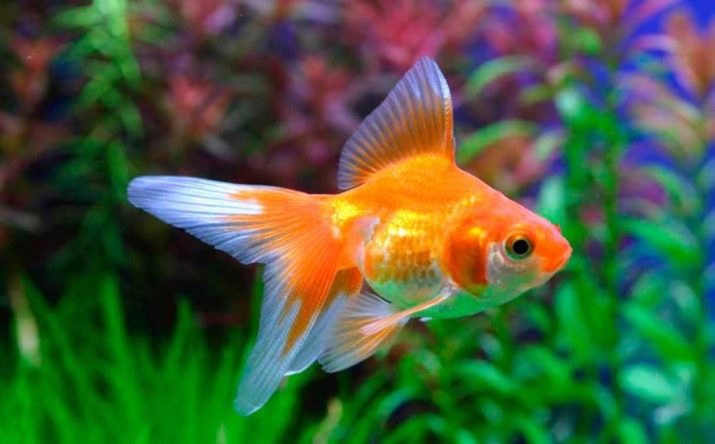
Important! To maintain optimal life in the aquarium, the water temperature should be around + 25– + 27 degrees. Perhaps, for certain types of fish, this temperature regime is not suitable.
Equipment and accessories
You can make aquarium farms yourself from improvised means, but it is much more convenient to purchase a ready-made kit in the store. The aquafarm is a vessel with a lid on which containers with a mesh bottom are located. The 11 liter aquarium is made of polycarbonate, indistinguishable in appearance from glass. This is a very light material.
Another important quality of such an aquarium is that it cannot break. It is strong and durable, it maintains the temperature regime inside the tank well. It has a special chamber for a water pump, silently lifting water up to the roots. A small hole for feeding fish is located in the lid.
Plants are not grown in soil, but in a special substrate - porous pumice. It is placed in containers with a net and inserted into a pallet. Through the net, the roots can sprout freely from the container. A pallet with 5 containers for seeds consists of polypropylene. The pump, built into the sump, works from the mains, there should be a socket nearby. The dehlorator conditioner removes chlorine from tap water, as well as salts and heavy metals, thereby creating a safe environment in the aquarium. The compact format allows you to place the farm on a window, desk or in the kitchen corner.
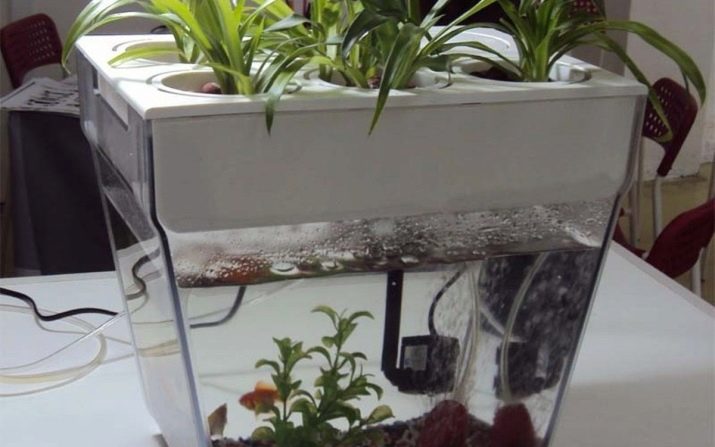
The standard set of water farms included various components.
The following elements are intended for the aquarium:
- transparent capacity;
- lid pallet with containers for seeds;
- pump (works from a network 220–240 V);
- packing with gravel (at the bottom of the aquarium);
- rubber tubes:
- flexible - to supply air to the aquarium with a tap;
- rigid - mounted in a pallet with a grid on one side;
Water will require the following elements:
- D-Klor - dehlorator conditioner for water purification from a water supply system;
- Zym Bac - a concentrate with beneficial bacteria that keep the water clean;
- TidyTank is a substance for removing contaminants from gravel and walls.
For fish, it is worth purchasing components such as:
- Fish Prep - organic food;
- Nature Pro Plus - therapeutic composition.
For plants, you will need such components as:
- containers for greens;
- a package of porous substrate for plants;
- set of environmentally friendly seeds.

Ecosystem launch
A water farm requires a minimum of maintenance costs, but first you need to start the ecosystem process. Doing it yourself is quite simple, there is an instruction manual in the kit. The assembly steps are step by step as follows:
- choose a place for the aquarium, it should be well lit and close to an electrical outlet;
- the set must be removed from the packaging: rinse the tank and pan;
- Now we need to assemble a farm on aquaponics;
- to connect a rigid rubber tube with a pump, but not connected to the power supply network at that time;
- wash gravel with hot water and pour to the bottom;
- pour neutral temperature water into the vessel (it can be left for about two days);
- pour 1 bag of Fish Prep and half a cap of dehlorator conditioner;
- the container with the fish is immersed in the aquarium for half an hour, then the fish is released, the carrying container is removed; first add a little water in the carrying to the fish first, wait about half an hour, and then proceed to this point;
- wash the pallet with containers;
- the wire from the pump and the rubber tube are passed through a slot in the pallet;
- put a lid with a pan on the aquarium;
- the substrate is washed with hot water directly in pots and placed on a tray;
- pour with a solution of Zym Bac, this will take the whole bottle;
- sow seeds in a container, it is better not to plant different types in one;
- setting to minimum power, connect the pump to a power outlet.

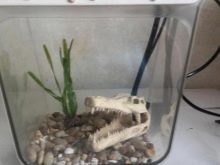
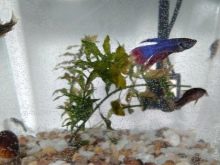
After installation, water may become cloudy immediately or several days later. If this happened immediately, it means that dirt and dust remained on the gravel, it is necessary to wait until it settles. In a few days, this can also happen, but this means that the biological process of water purification has yet to start. When all the inhabitants get used to each other, this should pass.
To decorate the aquarium, you can take artificial algae and small grottoes.
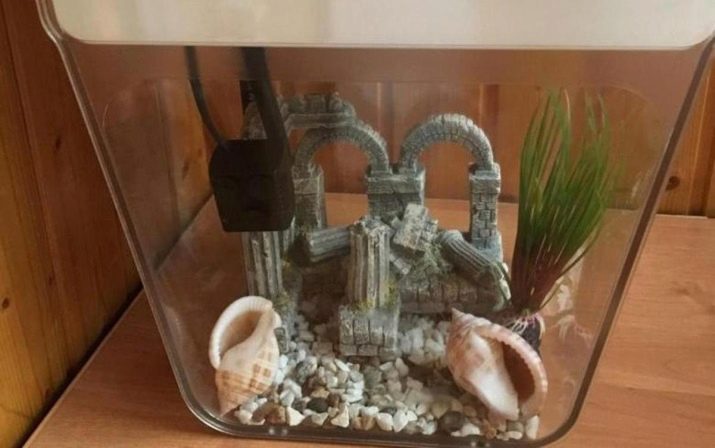
From the scenery, nothing superfluous should fall into the water: it nourishes the leaves that are consumed. Living plants in the aquarium are also not needed, they take food from those planted in pots, which will make them grow slower. It is not necessary to water the grown greens, but seeds and seedlings do not have a developed root system, so it is advised to spray them a little with water. Sprouted seeds grow very quickly, and soon they will not have to be watered at all.
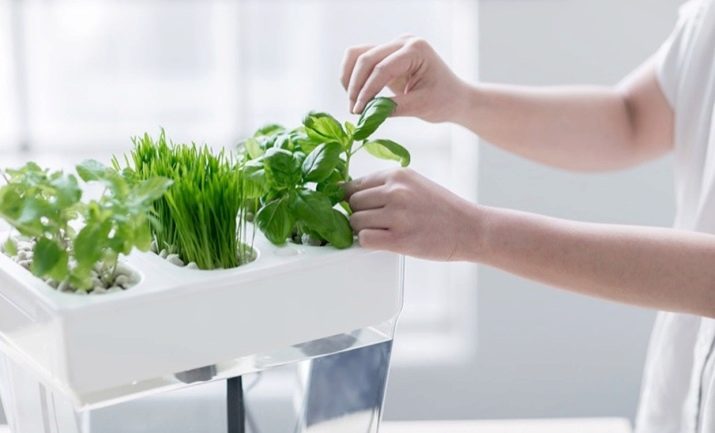
An ideal home-based aqua farm involves only daily feeding of fish: 1-2 pellets per fish.
From excess feed, water in the aquarium deteriorates; I can get sick from this fish.
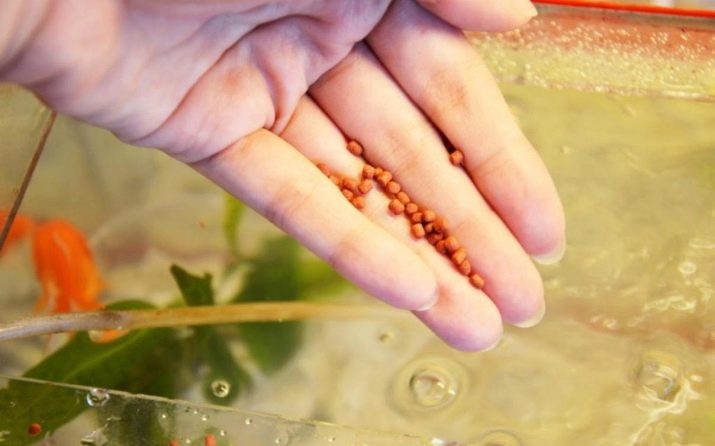
Water is periodically added to the tank as it decreases with the addition of a dehlorator conditioner: 1 cap per 6 liters. Each month, the aquarium is treated with a means to remove sediment from gravel and walls.
Review Reviews
Fishes swim in the water, small beds turn green before our eyes and give juicy and vitamin leaves all year round - this is how the brochures promise. It is worth considering what real buyers say. Families with children, such as an aquarium, which you don’t need to take care of, get this product, of course, and you can cut green salads to the table.
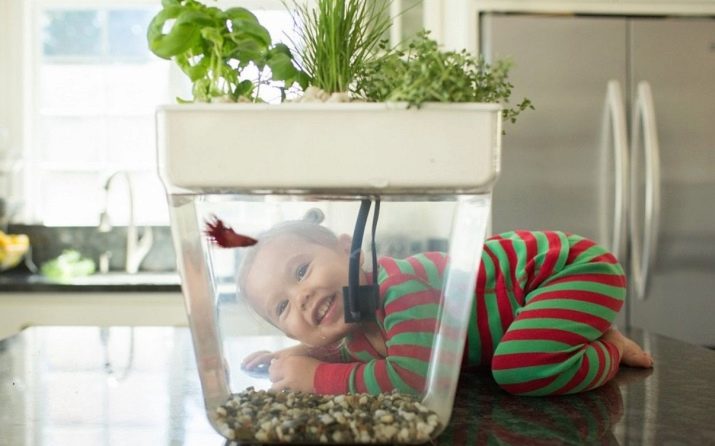
Only in some beginner aquafarmers, fresh greens do not grow: 1-2 leaves appear, and then only long stems stretch out. But Pecilia fish in the aquarium remove fry and feel great. Perhaps this may come from a lack of lighting.
Many owners note that it is rather difficult to find a suitable place for the aquarium with beds. Too intense sun causes water to bloom, and if there is partial shade, then the green will slow down growth due to lack of light. Others - put the aqua farm on the windowsill, the water does not turn green. A small living area is suitable for relaxing in the office center of a huge metropolis. A fish in the aquarium, the murmur of water and healthy greens above it - all this is obtained with minimal time and effort. It also calms the nerves, helps, distract and relax.
Some owners of the aquafarm find out that after the first harvest, mold appears on the containers, and the roots rot in the plants and they turn yellow. It is necessary to remove the diseased greens and thoroughly rinse the substrate before a new planting. And someone completely refused to grow greens and uses the aqua farm as a regular aquarium. One of the owners was forced to buy an additional temperature controller for heating, since the Siamese cockerel was cold in the aquarium. Others are not happy that water needs to be added to the aquarium very often, because it evaporates quickly.
According to most reviews, fish are happy to eat food from a set of aquafarm, but in a separate case, the standard type of food did not interest the fish. The owner had to choose individually than to feed the pets. All unanimously agree that this is a beautiful and entertaining acquisition, which is suitable for busy people as a way to relieve stress, and for beginner aquarists, especially children.
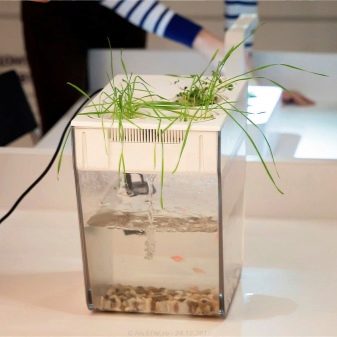
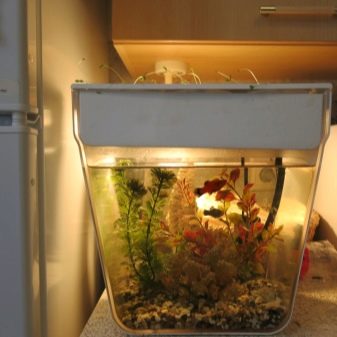
You will learn more about what a water farm is from the video.










